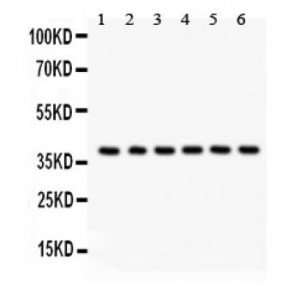More info
Overview
Long Name | Antibody Type | Antibody Isotype | Host | Species Reactivity | Validated Applications | Purification |
| serine/threonine kinase receptor associated protein | Polyclonal | IgG | Rabbit | Human, Rat | IHC-P, WB | Immunogen affinity purified. |
Immunogen | ||||||
| A synthetic peptide corresponding to a sequence at the N-terminus of human Unrip(78-104aa AADFTAKVWDAVSGDELMTLAHKHIVK), identical to the related mouse and rat sequences. | ||||||
Properties
Form | Lyophilized |
Size | 100 µg/vial |
Contents | Antibody is lyophilized with 5 mg BSA, 0.9 mg NaCl, 0.2 mg Na2HPO4, 0.05 mg NaN3. *carrier free antibody available upon request. |
Concentration | Reconstitute with 0.2 mL sterile dH2O (500 µg/ml final concentration). |
Storage | At -20 °C for 12 months, as supplied. Store reconstituted antibody at 2-8 °C for one month. For long-term storage, aliquot and store at -20 °C. Avoid repeated freezing and thawing. |
Additional Information Regarding the Antigen
Gene | STRAP |
Protein | Serine-threonine kinase receptor-associated protein |
Uniprot ID | Q9Y3F4 |
Function | The SMN complex plays a catalyst role in the assembly of small nuclear ribonucleoproteins (snRNPs), the building blocks of the spliceosome. Thereby, plays an important role in the splicing of cellular pre-mRNAs. Most spliceosomal snRNPs contain a common set of Sm proteins SNRPB, SNRPD1, SNRPD2, SNRPD3, SNRPE, SNRPF and SNRPG that assemble in a heptameric protein ring on the Sm site of the small nuclear RNA to form the core snRNP. In the cytosol, the Sm proteins SNRPD1, SNRPD2, SNRPE, SNRPF and SNRPG are trapped in an inactive 6S pICln-Sm complex by the chaperone CLNS1A that controls the assembly of the core snRNP. Dissociation by the SMN complex of CLNS1A from the trapped Sm proteins and their transfer to an SMN-Sm complex triggers the assembly of core snRNPs and their transport to the nucleus. STRAP plays a role in the cellular distribution of the SMN complex. Negatively regulates TGF-beta signaling but positively regulates the PDPK1 kinase activity by enhancing its autophosphorylation and by significantly reducing the association of PDPK1 with 14-3-3 protein. |
Tissue Specificity | |
Sub-cellular localization | Cytoplasm. Nucleus. Note: Localized predominantly in the cytoplasm but also found in the nucleus. |
Sequence Similarities | Belongs to the WD repeat STRAP family. |
Aliases | MAP activator with WD repeats antibody|MAWD antibody|PT-WD antibody|PTWD antibody|Serine-threonine kinase receptor-associated protein antibody| serine/ threonine kinase receptor associated protein antibody|STRAP antibody| STRAP_ HUMAN antibody|unr interacting protein antibody|unr-interacting protein antibody| UNRIP antibody|WD 40 repeat protein PT WD antibody|WD-40 repeat protein PT-WD antibody |
Application Details
| Application | Concentration* | Species | Validated Using** |
| Western blot | 0.1-0.5μg/ml | Human, Rat | AssaySolutio's ECL kit |
| Immunohistochemistry(Paraffin-embedded Section) | 0.5-1μg/ml | Human | AssaySolutio's IHC/ICC Detection kit |
AssaySolution recommends Rabbit Chemiluminescent WB Detection Kit (AKIT001B) for Western blot, and Rabbit Peroxidase IHC/ICC Detection Kit (AKIT002B) for IHC(P). *Blocking peptide can be purchased at $65. Contact us for more information

Anti- Unrip antibody, ASA-B1953, Western blotting
All lanes: Anti Unrip (ASA-B1953) at 0.5ug/ml
Lane 1: Rat Brain Tissue Lysate at 50ug
Lane 2: HEPG2 Whole Cell Lysate at 40ug
Lane 3: SMMC Whole Cell Lysate at 40ug
Lane 4: U87 Whole Cell Lysate at 40ug
Lane 5: Human Placenta Tissue Lysate at 50ug
Lane 6: HELA Whole Cell Lysate at 40ug
Predicted bind size: 38KD
Observed bind size: 38KD
All lanes: Anti Unrip (ASA-B1953) at 0.5ug/ml
Lane 1: Rat Brain Tissue Lysate at 50ug
Lane 2: HEPG2 Whole Cell Lysate at 40ug
Lane 3: SMMC Whole Cell Lysate at 40ug
Lane 4: U87 Whole Cell Lysate at 40ug
Lane 5: Human Placenta Tissue Lysate at 50ug
Lane 6: HELA Whole Cell Lysate at 40ug
Predicted bind size: 38KD
Observed bind size: 38KD

Anti- Unrip antibody, ASA-B1953, IHC(P)
IHC(P): Human Mammary Cancer Tissue
IHC(P): Human Mammary Cancer Tissue



